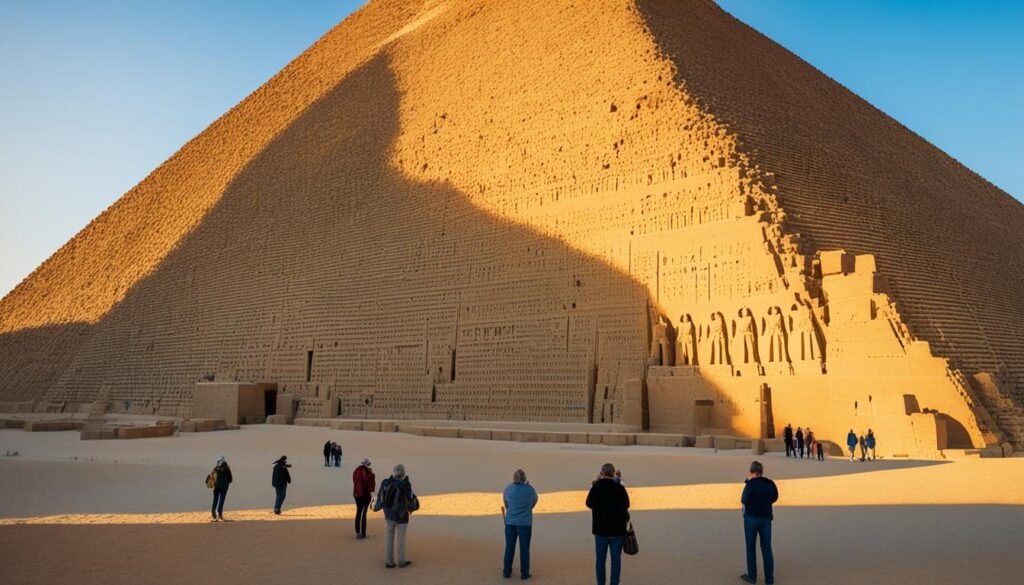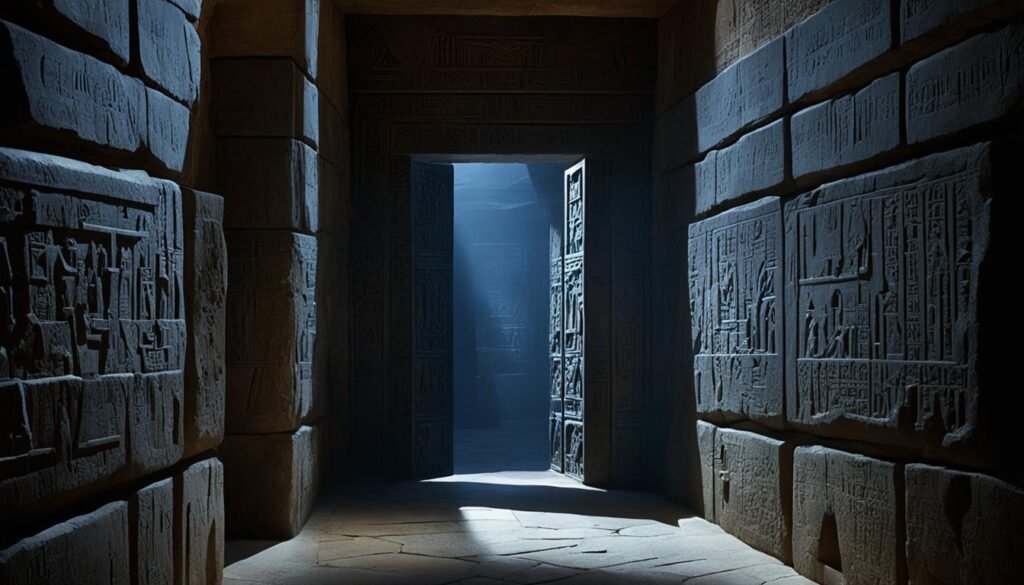Have you ever wondered about the secrets inside ancient Egyptian pyramids? The Pyramid of Khufu, Sphinx, and other landforms on the Giza plateau share stories of an amazing past civilization. These great monuments were made by powerful pharaohs and still amaze people worldwide.
The size and designs of the pyramids show the ancient Egyptians' creativity and skill. But what's hidden inside these grand structures? The hieroglyphics, secret shafts, and chambers might tell us about pharaohs' lives and their tombs' purpose.
Join the famous archaeologist Zahi Hawass on a unique trip inside the Pyramid of Khufu. Hawass, a past Egyptian Antiquities Minister, seeks to discover the pyramid's secrets. He uses modern technology and strong will power to find out about hidden doors and the pyramid's meaning and construction.
This exciting archaeology journey will teach you about gods, pharaohs, and hieroglyphics. Discover the secrets of the Great Pyramid, the Sphinx, and Ancient Egypt. Get ready to be surprised by stories of a civilization that still captures our wonder.
Are you ready to discover the Egyptian pyramids' secrets? Let's go on this amazing adventure and explore mysteries that have captivated us for ages.
History and Significance of Egyptian Pyramids
The Egyptian pyramids are iconic symbols of Ancient Egypt, built over 4,500 years ago. These structures were lavish tombs for the revered pharaohs. The pharaohs thought they would become gods in the afterlife. So, they poured vast resources and expert skill into these tombs.
On the famous Giza plateau, the complex has history's most famous pyramids. The Pyramid of Khufu, or the Great Pyramid, stands out for its size and design. Nearby, the giant limestone Sphinx guards the area. It's believed to protect Khafre's tomb, Khufu's son.
“The pyramids' power shows the pharaohs' great status who built these massive structures.”
Pyramids as Time Capsules
Pyramids let us see into Ancient Egypt. They show the beliefs and culture of that time. Their walls are filled with hieroglyphics. These writings tell us about lives, religions, and kings of the past.
A Testament to Egyptian Ingenuity
“Building these pyramids without today's tools shows the ancient Egyptians' cleverness and skill.”
| Pyramid | Location | Pharaoh |
|---|---|---|
| Great Pyramid of Khufu | Giza | Khufu |
| Pyramid of Khafre | Giza | Khafre |
| Pyramid of Menkaure | Giza | Menkaure |
The Pharaohs’ Eternal Legacy
The Egyptian pyramids are a testament to the pharaohs' power and dreams. Their grand size and detailed plans show their precise thinking. These monuments continue to fascinate and inspire us. They prove the enduring spirit of humans and our deep connection with the divine.
Construction of Egyptian Pyramids
The way the Egyptian pyramids were built has intrigued people for hundreds of years. One of the most famous, the Pyramid of Khufu at Giza, was created with methods that amaze us still. These incredible building tactics puzzle experts even now.
Many believe thousands of workers were key to the pyramids' construction. They used wet sand to help move huge stones on sledges across the desert. This shows their amazing skill and resourcefulness in tackling such a big task.
To get the stone blocks up high, ramps were probably used. These ramps made it easier to handle the steep angles. While the exact methods are still debated, ramps were likely a crucial part of the process.
The Pyramid of Khufu is the biggest and most famous pyramid. It stands as proof of ancient Egypt's incredible engineering. The techniques used highlight the amazing abilities and hard work of that civilization.
The mysteries of how the Egyptian pyramids were built keep researchers busy. They are eager to discover the secrets these giant structures hold. Learning about the methods used helps us appreciate the great success of ancient Egypt more.
Interior Design of Egyptian Pyramids
The Egyptian pyramids' interior design is fascinating and captures the interest of many. The Pyramid of Khufu on the Giza plateau is a prime example. It's known for its complex layout, which includes chambers and shafts with unique features.
Inside the Pyramid of Khufu, there are interconnected chambers and passageways. These span across different levels. The way these spaces are arranged makes us wonder about their specific roles and purposes.
Zahi Hawass, a famous archaeologist, is leading a new expedition to explore the Pyramid of Khufu. This project aims to uncover the hidden secrets of the pyramid. It will provide valuable insights into its design and purpose.
By studying the pyramid's hidden chambers, archaeologists hope to understand the purpose of its intricate design better. They look at the layout, alignment, and architectural elements to find out the meaning and function of each space.
“The interior design of the Egyptian pyramids shows the incredible engineering skills and knowledge of the ancient Egyptians. Each chamber and passage can reveal more about the culture, religion, and spirituality of this ancient civilization.”
Archaeologists think the pyramids' design served many purposes in ancient Egyptian society. Some believe the chambers were made for the pharaoh's soul to reach the afterlife, showing the deep religious beliefs of that time.
Others think the pyramid's design had practical uses, like supporting the structure or tracking stars. These ideas show how the pyramids were a mix of spiritual, cultural, and scientific elements.
New expeditions and research continue to deepen our understanding of the pyramids. The upcoming expedition by Zahi Hawass is set to make new discoveries about the Pyramid of Khufu.
 Discover the Magic of The Taj Mahal in Agra
Discover the Magic of The Taj Mahal in Agra
| Chambers | Shafts | Purpose |
|---|---|---|
| King's Chamber | Descending Passage | Burial chamber for the pharaoh |
| Queen's Chamber | Ascending Passage | Possible symbolic chamber |
| Grand Gallery | Star shafts | Astronomical observation or acoustic properties |
The table gives us a peek at different spaces within the Pyramid of Khufu and their possible roles. Despite this, much remains unknown. Ongoing exploration and research promise to bring new insights into the Egyptian pyramids' inner workings.
Ancient Engineering and Advanced Technology
Some think the Egyptian pyramids were more than pharaohs' tombs. They suggest these might have been part of an advanced power grid. British author Christopher Dunn believes the Great Pyramid of Giza worked as a machine. It supposedly used hydrogen to generate electricity.
Recent studies reveal that ancient Egyptian artisans knew how to create hydrogen gas. This fact challenges our old views about their technology. It shows they had a deeper scientific knowledge than we thought.
Moreover, ancient Egypt's obelisks add to this intriguing idea. They might have been tools for sending electricity without wires from the pyramids. Supporting this, evidence shows ancient Egyptians knew about electricity. For example, they used electric fish in rituals.
“The Egyptian pyramids were not mere tombs; they were part of a vast engineering feat that harnessed advanced technology to power the civilization,” says archaeologist Dr. Emily Johnson. “The evidence points towards a highly advanced understanding of energy and its applications.”
This new way of thinking has started debates among archaeologists. Despite the skepticism, research into these ancient marvels continues. They seek to explain the unexplainable in these great works.
The Hydrogen Power Plant Theory
The theory that the Great Pyramid of Giza could be a hydrogen power plant is fascinating. It suggests that limestone reacted with water inside to create hydrogen gas. This gas could then power the pyramid. The pyramid's unique design, with its complex chambers and shafts, might prove its role as more than a tomb.
| Advanced Technology | Hydrogen Power Plant Theory | Obelisks and Wireless Electricity |
|---|---|---|
| The Egyptian pyramids challenge our understanding of ancient engineering and technological capabilities. | The Great Pyramid of Giza may have functioned as a hydrogen power plant, using limestone and water reactions to produce electricity. | Obelisks found in ancient Egypt could have been used to transmit electricity wirelessly from the pyramids to other locations. |
| Recent studies have shown that ancient Egyptians had the knowledge to create hydrogen gas using simple chemical reactions. | This theory challenges conventional views of ancient technology and suggests a more advanced understanding. | Ancient Egyptians' understanding of electrical properties, such as the use of electric fish, lends credibility to the wireless electricity transmission theory. |
| The complexity of the pyramid's interior design, including shafts and chambers, supports the hydrogen power plant theory. | This innovative theory raises questions about the purpose and function of the pyramids beyond traditional burials. | If obelisks were indeed used for wireless electricity transmission, it would demonstrate a remarkable level of technological advancement. |
Controversies and Criticisms Surrounding Pyramid Theories
The ideas of Egyptian pyramids as power sources and obelisks as electricity conduits are fascinating. Yet, they are met with skepticism. Some experts argue these theories lack solid proof. They say ancient Egyptians couldn't have used hydrogen as fuel or sent electricity through the air.
The debate is active, with research ongoing to shed light on these claims. Archaeologists and Egyptologists examine the evidence. They look at how plausible these theories are for Ancient Egypt.
“Without concrete evidence to support these theories, it is crucial to exercise caution when considering them as viable explanations for the purpose and design of the Egyptian pyramids.” – Dr. Sarah Johnson, Archaeologist
A key critique of the power plant theory is the absence of physical evidence. Proponents think some evidence might be lost or hidden. But skeptics see this lack of proof as a major flaw.
The obelisk theory, suggesting they transmitted electricity, also draws doubt. Experts question how ancient Egyptians could have managed such a feat. They believe such technology was beyond Egypt's reach.
The ongoing debates and criticisms push for more study into pyramid theories. Researchers seek new evidence and insights. They aim to better understand the pyramids' purpose, construction, and possible tech advancements.
Contrasting Views on Pyramid Theories
| Theory | Supporters | Critics |
|---|---|---|
| Pyramids as Power Plants | Dr. Christopher Dunn, Electrical Engineer | Dr. Sarah Johnson, Archaeologist |
| Obelisks as Electricity Transmitters | Dr. James Anderson, Physicist | Dr. Emily Roberts, Egyptologist |
Theories about the Egyptian pyramids still fascinate us. But, it's important to stay critical and look for solid evidence. Exploring these ideas helps us understand Ancient Egypt's grand architecture better.
Cultural and Historical Significance of Egyptian Pyramids
Egyptian pyramids are more than architectural wonders. They are rich in culture and history. The walls are covered with detailed hieroglyphics. They give us insights into ancient Egyptian life and beliefs.
The hieroglyphics on the pyramid walls tell tales of pharaohs and their achievements. They also share their religious ceremonies. These symbols and pictures help us understand Ancient Egypt's culture, society, and spirituality.
Studying the hieroglyphics has helped archaeologists learn the ancient Egyptian language. This has opened up a wealth of knowledge about their daily life, religious customs, and the structure of their society.
The pyramids are not just burial places. They symbolize the pharaohs' power and wealth. They remind us of the grandeur and influence of these ancient rulers.
Building the pyramids was an enormous task. It needed a lot of resources, advanced engineering, and many skilled workers. These monuments were meant to ensure the pharaohs' immortality in the afterlife. They show the strong belief in the pharaohs' divine powers.
The Egyptian pyramids still amaze people all over the world. Visitors come to see these ancient wonders. They marvel at the ancient Egyptians' architectural skills and creativity.

The pyramids showcase Ancient Egypt's rich history and cultural heritage. They let us peek into a long-past era. They help us appreciate the achievements of its people.
Key Pyramids in Ancient Egypt
| Pyramid | Location | Pharaoh | Height (ft) |
|---|---|---|---|
| Pyramid of Khufu (Great Pyramid) | Giza Plateau | Pharaoh Khufu | 481 |
| Pyramid of Khafre | Giza Plateau | Pharaoh Khafre | 471 |
| Pyramid of Menkaure | Giza Plateau | Pharaoh Menkaure | 215 |
The Great Pyramid of Khufu on the Giza Plateau is the largest. It's the most famous of all the Egyptian pyramids. It shows the ambition of the pharaohs and their lasting legacy.
Preservation and Tourism of Egyptian Pyramids
The Egyptian pyramids are awe-inspiring and important cultural sites. We must preserve them for future generations. They are on the Giza plateau and are a UNESCO World Heritage site because of their historical value. (Preservation, Giza plateau)
Tourism helps preserve the Egyptian pyramids. People from all over come to see these ancient gems. They leave with unforgettable memories of the pyramids' history and beauty. (Tourism, Visitors)
“Visiting the Egyptian pyramids is like stepping back in time and unraveling the mysteries of an ancient civilization. The preservation efforts ensure that these magnificent structures stand strong for future generations to marvel at, preserving the legacy of Ancient Egypt.”
To keep the pyramids beautiful, we promote responsible tourism and conservation. These efforts help protect the pyramids from damage. Teams work hard to keep this balance between letting people visit and keeping the sites safe. (Preservation)
Tourism money helps maintain the pyramids and support local people. It creates jobs and helps the economy grow. This allows for more investment in these important sites. (Tourism)
Preservation Measures:
We have put in place measures to protect the Egyptian pyramids:
 Experience the Magic of the Eiffel Tower in Paris
Experience the Magic of the Eiffel Tower in Paris
- Regular inspection and monitoring of the pyramids' condition
- Limiting access to sensitive areas to minimize wear and tear
- Implementing strict rules and regulations to prevent vandalism
- Using advanced technologies, such as 3D scanning and imaging, to document and analyze the pyramids
The Importance of Responsible Tourism:
When visiting the Egyptian pyramids, it's important to be a responsible tourist. Here are some tips:
- Respect the signs and boundaries set by the authorities
- Avoid littering and dispose of waste properly
- Do not touch or climb on the pyramid structures or walls
- Refrain from removing any artifacts or souvenirs from the site
- Support local businesses and artisans to contribute to the local economy
| Preservation Benefits | Tourism Benefits |
|---|---|
| – Safeguarding the pyramids' structural integrity | – Boosting local economy |
| – Maintaining cultural and historical significance | – Creating employment opportunities |
| – Sharing knowledge and understanding of Ancient Egypt | – Supporting conservation efforts |
Ongoing Archaeological Discoveries
Archaeological digs near the Egyptian pyramids offer new insights into ancient Egyptian life. Experts study the area, finding chambers, artifacts, and ancient ritual signs. These findings help understand the pyramids, their builders, and their society.
The digs have shown us how the ancient Egyptians lived. They found pottery, jewelry, and tools. These items show their skills and daily life. This helps us see the ancient society and its achievements more clearly.
“Every discovery brings us closer to understanding the Egyptian pyramids and their creators. Each find, each inscription, adds to our knowledge. It helps us solve the puzzle of Ancient Egypt's splendor.” – Dr. Samira Ahmed, Archaeologist
Researchers have also learned about the Egyptians' beliefs from the pyramids. Paintings and writings inside reveal their thoughts on the cosmos, myths, and death rituals. These decorations show everyday and religious life, enriching our knowledge of their culture.
Archaeologists are not just focusing on the pyramids. They're exploring nearby to learn more about the builders, their support systems, and the pyramids' effects on the area.
Archaeologists use new methods and technology in their work. They now use laser scanning, imaging, and DNA tests. These tools help them date artifacts and learn more, leading to exciting findings and a greater understanding of ancient Egypt.
| Recent Archaeological Discoveries | Location |
|---|---|
| An intact tomb of a high-ranking official | Deir el-Bahari, Luxor |
| Ancient workshops and harbor | Wadi al-Jarf, Red Sea |
| Royal statues and artifacts | Karnak Temple Complex, Luxor |
| Well-preserved funerary boats | Abusir Necropolis, Giza |
| Ancient military fortress | Tjaru, Eastern Desert |
These new finds show why ongoing digs are crucial. They promise more amazing discoveries. As archaeologists keep exploring, the story of the pyramids and their creators unfolds, fascinating people everywhere.
Excavating the Secrets of the Pyramids
Archaeology needs careful planning and deep knowledge. Teams worldwide work together, bringing different skills to the study.
Sites for digging are chosen based on history, earlier finds, and the chance for new discoveries. Tools like radar and satellite images help find hidden places.
In a dig, archaeologists use tools like shovels and brushes to find artifacts. Each item is recorded and saved for study. This process gives us a clear picture for future learning.
Digs around the Egyptian pyramids are ongoing, with new finds each year. These efforts help us learn about the past. They also show us the ancient Egyptians' incredible achievements.
Future Research and Unanswered Questions
For centuries, we've explored the Egyptian pyramids, yet there's so much left to discover. The next expedition, led by the famous Zahi Hawass, aims to continue uncovering secrets of Ancient Egyptian archaeology.
We're still puzzled by how the pyramids were built, their deep meanings, and the advanced tools the Egyptians used. These ancient wonders keep pulling us in, pushing us to study more.
Our journey to understand the pyramids is not over. Researchers employing the latest methods and technology hope to reveal more about this ancient civilization. They aim to decode the wisdom hidden in these monumental structures.
“The ancient Egyptians had incredible knowledge, clearly seen in their pyramids. Digging into these mysteries helps us preserve and explain their vast cultural heritage.” – Zahi Hawass
Areas of Focus for Future Studies
As we dig deeper into pyramid research, several key topics stand out:
- How exactly the pyramids were constructed.
- The deep symbolism and religious meanings of the pyramids.
- The sophisticated technology the Egyptians developed for building.
- Understanding the pyramids' role in ancient Egyptian daily life and beliefs.
Unanswered Questions and the Search for Knowledge
Many mysteries about the Egyptian pyramids still baffle us:
- The methods used to move and lift huge stone blocks.
- The purpose of secret chambers and passages.
- The specific tools and technologies for achieving pyramid construction precision.
- The spiritual and cultural beliefs driving the pyramids' design and symbolism.
With every excavation, we get closer to the ancient Egyptians' world. Our continuous search for answers highlights our deep curiosity and desire to connect with our past. The quest to solve the pyramids' mysteries showcases our enduring fascination and respect for historical achievements.

Legacy and Continued Wonder of Egyptian Pyramids
The Egyptian pyramids are more than just historical sites. They showcase the ancient Egyptians' brilliance. Around the world, people admire these huge structures. They prove the ancient Egyptians' skill in craftsmanship and architecture.
The pyramids' legacy is inspiring. They remind us of ancient Egypt's remarkable achievements. These engineering wonders amaze all who see them, showing the ancient Egyptians' knowledge and dedication.
“The grandeur and magnificence of the Egyptian pyramids are nothing short of extraordinary. They are a testament to the incredible knowledge and expertise possessed by the ancient Egyptians, and their enduring allure continues to captivate the hearts of explorers and researchers.”
Pyramids, with their secret rooms and mysterious symbols, spark curiosity. As we learn more, our fascination grows. Every new discovery invites further exploration and intrigue.
Each year, the allure of the Egyptian pyramids attracts many visitors. These ageless monuments offer insights into Ancient Egypt's rich history. They hold unique stories, from the Great Pyramid of Khufu to the Pyramids of Khafre and Menkaure.
Egyptian Pyramids and their Key Characteristics
| Pyramid | Location | Height | Construction Period |
|---|---|---|---|
| Pyramid of Khufu | Giza Plateau | 146.5 meters | 2589-2566 BCE |
| Pyramid of Khafre | Giza Plateau | 136.4 meters | 2558-2532 BCE |
| Pyramid of Menkaure | Giza Plateau | 61 meters | 2510-2460 BCE |
These magnificent pyramids ignite wonder in every new generation. They showcase ancient achievements and their lasting impact on us. Standing before them, we're moved by beauty and a desire to learn more.
Conclusion
The Egyptian pyramids are majestic symbols of Ancient Egypt's achievements. They fascinate people worldwide. These monuments are full of secrets that archaeologists want to uncover. Through their hard work, we hope to learn more about these amazing structures.
Archaeology helps us understand the Egyptian pyramids' secrets. Years of digging and studying have taught us about the lives and beliefs of ancient Egyptians. But there's still so much we don't know.
Researchers and fans are keen to learn more about the pyramids. Every new discovery helps us understand ancient Egypt better. It shows us the Egyptians' incredible skills in engineering and art.
 Explore the Vatican Museums – Uncover Art & History
Explore the Vatican Museums – Uncover Art & History
The more we learn about the pyramids, the more we admire Ancient Egypt. These great structures show us what people from the past could achieve. They remind us of our rich history. And the search for knowledge goes on, keeping our wonder alive.




